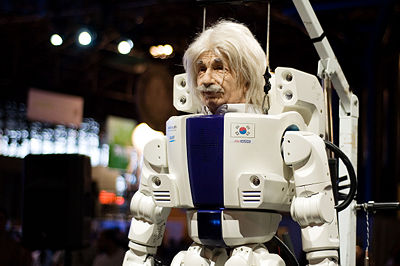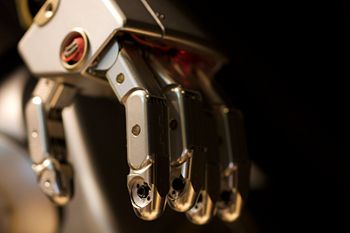HUBO: Difference between revisions
imported>Chunbum Park |
imported>Chunbum Park |
||
| Line 29: | Line 29: | ||
The subsequent efforts on HUBO's development were international in scope, the first of which involved the [[Hanson Robotics]] in the creation of the Albert HUBO. Albert HUBO was a derived version of the KHR-3 HUBO, but with a distinctive head resembling [[Albert Einstein]]. The head, which was made by the Hanson Lab, featured a [[Frubber]] skin (often used in movie productions) and 35 joints underneath it to make realistic facial expressions. Like its predecessors, Albert HUBO contained 2 CCD cameras for vision recognition.<ref name="Albertspecs"/> | The subsequent efforts on HUBO's development were international in scope, the first of which involved the [[Hanson Robotics]] in the creation of the Albert HUBO. Albert HUBO was a derived version of the KHR-3 HUBO, but with a distinctive head resembling [[Albert Einstein]]. The head, which was made by the Hanson Lab, featured a [[Frubber]] skin (often used in movie productions) and 35 joints underneath it to make realistic facial expressions. Like its predecessors, Albert HUBO contained 2 CCD cameras for vision recognition.<ref name="Albertspecs"/> | ||
Following the unveiling of Albert HUBO in November 2005, KAIST researchers proceeded to | Following the unveiling of Albert HUBO in November 2005, KAIST researchers proceeded to work on two technology demonstrators, which were HUBO FX-1, a biped designed for human ride, and HUBOWAY, like [[Segway]]. Putting HUBO ontop of HUBOWAY helped to renew publicity on HUBO when HUBOWAY and HUBO FX-1 were made public during the summer of 2007.<ref name="gearfuse">Dobrow, Andrew. "Hubo Becomes First Robot to Ride Segway." ''GEARFUSE''. 1 June 2007. Web. 26 Feb. 2011. <http://www.gearfuse.com/hubo-becomes-first-robot-to-ride-segway/>.</ref><ref name="gizmofx">Frucci, Adam. "Chairbot Walks You Around While You Sit." ''Gizmodo''. 5 June 2007. Web. 26 Feb. 2011. <http://gizmodo.com/#!266168/chairbot-walks-you-around-while-you-sit>.</ref> | ||
====HUBO 2 (2008~2009)==== | ====HUBO 2 (2008~2009)==== | ||
Revision as of 22:23, 26 February 2011
|
HUBO, short for "humanoid robot," refers to the humanoid robots and the related technology demonstrators developed at the humanoid robotics lab (hubo lab) at KAIST. As with other humanoid projects, the main focus of HUBO's development has been on bipedal locomotion, such as walking, running, and traversing the stairs, which is the essential basis for testing and implementing theories on human-robot interaction and artification intellience. HUBO was officially unveiled to the public on January 6, 2005, after four years of research with three earlier prototypes. Its younger siblings are Albert HUBO and HUBO 2.[1][2]
Development history
The first HUBO (KHR-3) was developed by mechanical engineering professor Oh Junho and his Ph.D. student teams over the course of about 20 years. During much of this time, the technologies relevant to HUBO were acquired at a steady pace with contributions from within KAIST. This informal approach resulted in a very low development cost of around $500,000 by the time of KHR3's completion. (In comparison, Honda is believed to have spent $300 million on ASIMO between 1986 and 2000.)[3][4]
Prototypes (2001~2004)
The first prototype was the KHR-0 (KAIST Humanoid Robot), consisting of two legs without an upper body. It was built in 2001 with the purpose of investigating the specifications of the actuators (devices that receive electric signals and perform mechanical actions) and the optimal design parameters of the humanoid robot.[5][6]
The second prototype, the KHR-1, was completed by January 2002. The KHR-1 was humanoid in form, but without the head and hand components that are nonessential for walking. Its purpose was to demonstrate autonomous walking that involves real-time motion control through sensory feedback. (This involves constant adjustments that are absent in playback walking from an offline learning process and partially adjusted walking.) It could walk at speeds up to 0.8 km/h and change its direction.[5][7][8][6]
The project was continued with the development of KHR-2 from 2003 to 2004. The KHR-2 was built as a complete humanoid and featured improved sensoring with the addition of CCD cameras, inertia sensors, and tilt sensors.[9] It was used as a platform for simulating vision-guided dynamic walking, in which the robot maintains focus on a moving red light.
KHR-3 HUBO (2004~2005)
Work on the KHR-3 HUBO was begun in September 2004. The internal components were covered with metallic grey plastic, and modifications were made to the joints and and the skeleton for greater stiffness and minimal mechanical uncertainty. The KHR-3's physical specifications, such as height, weight, and the number of DOFs (degrees of freedom), were similar to Honda's ASIMO, which served as the benchmark for the project. In terms of AI and movements, HUBO fell short of the "next-gen ASIMO," which was unveiled three months later. While HUBO could only walk at 1.25 km/h, the ASIMO was capable of walking at 2.5 km/h and running at 3 km/h as well. The ASIMO was also capable of walking up and down stairs, which was a temporary shortcoming for HUBO needing further development. The unnerved KAIST researchers noted, however, that HUBO could play rock-paper-scissors, which was impossible for ASIMO since its fingers could not move independently of each other.[10][11][12]
International collaboration
The HUBO project drew considerable attention from abroad when the KHR-3 HUBO was unveiled in January 2005. According to an interview with Professor Oh,[4]
When KHR-2 was announced, Japanese scholars were surprised. Those Honda figures involved with ASIMO mostly knew what was going on, so I have yet to hear a direct response from them since HUBO was announced. I've just gotten faxes and emails from abroad, mostly asking if they could buy it or rent it. I also got an email from a Microsoft official who said he'd like to meet since they would like to do robot-related research. I've gotten responses from Taiwan and the United States praising HUBO.
Albert HUBO, HUBO FX-1, and HUBOWAY (2005~2007)
The subsequent efforts on HUBO's development were international in scope, the first of which involved the Hanson Robotics in the creation of the Albert HUBO. Albert HUBO was a derived version of the KHR-3 HUBO, but with a distinctive head resembling Albert Einstein. The head, which was made by the Hanson Lab, featured a Frubber skin (often used in movie productions) and 35 joints underneath it to make realistic facial expressions. Like its predecessors, Albert HUBO contained 2 CCD cameras for vision recognition.[2]
Following the unveiling of Albert HUBO in November 2005, KAIST researchers proceeded to work on two technology demonstrators, which were HUBO FX-1, a biped designed for human ride, and HUBOWAY, like Segway. Putting HUBO ontop of HUBOWAY helped to renew publicity on HUBO when HUBOWAY and HUBO FX-1 were made public during the summer of 2007.[13][14]
HUBO 2 (2008~2009)
Following the unveiling of Albert HUBO in November 2005, KAIST researchers proceeded to create various technology demonstrators related to HUBO, which were HUBO FX-1, a biped designed for human ride, and HUBOWAY, like Segway. Placing HUBO ontop of HUBOWAY helped to renew publicity and interest on the project, without the need for a different configuration from of a human user.
HUBO 2's initial development concerning the mechanical aspect was done at KAIST from 2008 to 2009. The HUBO 2 was given a slimmer design with an aluminum endoskeleton and a polycarbonate frame, resulting in a slightly taller height but a 20% lighter weight than its predecessors. Its movements were more realistic since the arms made quicker and more natural motions, and the legs could stretch to imitate human walking, which is more efficient than the traditional humanoid walking by bending the legs to keep the height of the hips constant. With these improvements, HUBO 2 could walk at 1.4 km/h and also run at 3.6 km/h (which is still much slower than the new ASIMO's 6 km/h by comparison).[15][16][17]
HUBO 2 (also known as KHR-4 and Jaemi HUBO — "Jaemi" (재미) can mean "in the United States" in Chinese characters or "fun" in colloquial Korean) was a more extensive and strategic effort to combine Korea's expertise in humanoid design with the US's strength in cognition, perception, navigation, and networking. It involved participation of KAIST, Korea University, and the Seoul National University in South Korea, and the Bryn Mawr College, Colby College, Drexel University, the University of Pennsylvania, and Virginia Tech in the United States under a $5 million dollar, 5-year program funded by the National Science Foundation.[2][18]
Design and engineering principles
Central to HUBO's successful development was its focus on simpler and feasible design and movements. For HUBO to be light and efficient, its height was set similar to a child's, and the body was made with special materials (HUBO 2). Its autonomous design lacking external connections helps to both simulate realistic walking and reduce its exposure to outside factors that would increase its chances of error.[8][5]
All models were built with harmonic drives in order to avoid backlash in the gears and to achieve a light, compact design. The DOFs of the different axes in the joints of shoulders, waist, hips, and ankles were merged into intersections in order to attain a simple, closed-form solution (that is, comprised of well-known mathematical functions) of inverse kinematics (the computation of the robot's movements), when possible.[6][5]
HUBO's walking from KHR-1 to KHR-3 and Albert HUBO involved bending of legs characteristic of walking by a human stalker. The benefits of this type of walking include lowered center of gravity for greater stability and simpler inverse kinematics of movements fixed on Zero Moment Points. The ZMP trajectory consists of points on the ground where the total moment of inertia of the active forces equals to zero when one leg is in contact. The trajectory is calculated with a simple model to form a repetitive pattern, in which the robot is always in touch with the ground, and the initial and end phases of its legs' movements are identical.[19]
HUBO 2, on the other hand, is able to walk like a human, which is faster than curved walking because it reduces unnecessary movement and relieves burden on the knee components. Straight walking was first demonstrated by Yu Ogura on WABIAN-2 with the addition of an extra DOF at the waist that caused it to sway to a certain degree. Unlike the Wabian-2, Jaemi HUBO clings to a natural set of DOFs and instead relies on a system of posture control consisting of body-balancing and vibration-reduction units.[19]
Biped walking speed is naturally restricted, however, due to the limited range of the hip joint (which makes the forward movement of the leg). HUBO 2 can move more quickly by running, which includes a flying phase when both its feet are off the ground. Running is not as structurally limited as walking because the robot continues to move forward midair even as its hip joint reverses motion. By rotating its upper body against the one-sided thrusting motion of its legs, the robot is able to maintain a periodic running pattern based on a trajectory of the angular momentum of its center of mass.[20]
Notes
- ↑ Birth of Korean Humanoid Robot Marks Brilliance Advance in Korea Robotics, Chosun Ilbo. 2004-12-22.
- ↑ 2.0 2.1 2.2 Specification of Albert HUBO, Hubo Lab. Date accessed: 2009-02-24.
- ↑ 한국형 휴먼로봇 '휴보' 탄생, Chosun Ilbo. 2004-12-22.
- ↑ 4.0 4.1 Korean Robotics Steps Into the Future, Lee Sung Kyu and Todd Thacker, OhmyNews International. 2005-01-18.
- ↑ 5.0 5.1 5.2 5.3 Oh, et al, "Design and Walking Control of the Humanoid Robot, KHR-2(KAIST Humanoid Robot - 2)," 2004.
- ↑ 6.0 6.1 6.2 Oh, et al, "Mechanical Design of the Humanoid Robot Platform, HUBO," 2007.
- ↑ Introduction of KHR-1, Hubo Lab. Date accessed: 2009-02-20.
- ↑ 8.0 8.1 Oh, et al, "Development of a Humanoid Biped Walking Robot Platform KHR-1 - Initial Design and Its Performance Evaluation," 2002.
- ↑ Introduction of KHR-2, Hubo Lab. Date accessed: 2009-03-09.
- ↑ Specification of KHR-3 (HUBO), Hubo Lab. Date accessed: 2009-02-24.
- ↑ Honda Reveals Technologies Next-Generation ASIMO, Honda. 2004-12-15.
- ↑ Korea to unveil stair-walking robots, Korea.net. 2006-02-25.
- ↑ Dobrow, Andrew. "Hubo Becomes First Robot to Ride Segway." GEARFUSE. 1 June 2007. Web. 26 Feb. 2011. <http://www.gearfuse.com/hubo-becomes-first-robot-to-ride-segway/>.
- ↑ Frucci, Adam. "Chairbot Walks You Around While You Sit." Gizmodo. 5 June 2007. Web. 26 Feb. 2011. <http://gizmodo.com/#!266168/chairbot-walks-you-around-while-you-sit>.
- ↑ KAIST 휴보 '미국 로봇 교과서'로 쓰인다, Chosun Ilbo. 2009-06-08.
- ↑ Introduction of HUBO (KHR-4), Hubo Lab. Date accessed: 2009-11-09.
- ↑ 시속 3.6㎞로 뛰는 로봇 세계 세 번째로 개발, JOINS. 2009-12-05.
- ↑ U.S. and Korean Researchers Unveil Newest Research Team Member: Jaemi the Humanoid, NSF. 2009-06-01.
- ↑ 19.0 19.1 Oh et al, Realization of Stretch-legged Walking, 2008. pp. 118
- ↑ Cho and Oh, 2009. pp. 7
- Incompatible editor status
- Editable Main Articles with Citable Versions
- CZ Live
- Computers Workgroup
- Engineering Workgroup
- Physics Workgroup
- Technology Subgroup
- Articles written in British English
- Advanced Articles written in British English
- All Content
- Computers Content
- Engineering Content
- Physics Content
- Technology tag


